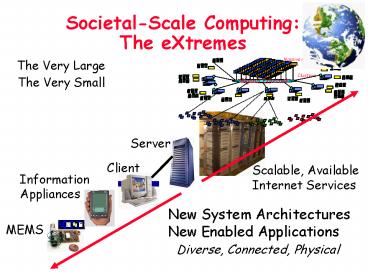Societal-Scale Computing: The eXtremes - PowerPoint PPT Presentation
Title:
Societal-Scale Computing: The eXtremes
Description:
Significantly more convenient for people to interact with information, devices, ... Endeavour Project: 21st Century. Computing & Communications at the Extreme ... – PowerPoint PPT presentation
Number of Views:21
Avg rating:3.0/5.0
Title: Societal-Scale Computing: The eXtremes
1
Societal-Scale ComputingThe eXtremes
New System Architectures New Enabled
Applications Diverse, Connected, Physical
MEMS
2
Motivation and Goals
- Exploiting IT to enhance understanding
- Significantly more convenient for people to
interact with information, devices, and other
people than todays systems - Pervasive use of introspection and exploitation
of tacit information - Supported by a reliable, scalable
planetary-scale Information Utility - Technical Approach Pervasive Information
Utility, based on new concept of fluid systems,
supporting innovative applications for problem
solving learning
3
The Coming Revolution
4
System Architecture for Vastly Diverse
DevicesLeader Culler
- The Large Enable distributed creation
deployment of scalable, available services - The Small Small Device OS for Dust Motes
5
Endeavour Project 21st CenturyComputing
Communications at the Extreme
- R. H. Katz, Principal Investigator
- J. Canny, D. Culler, M. Franklin, J. Hellerstein,
A. Joseph, J. Kubiatowicz, J. Landay, D.
Patterson, K. Pister, L. Rowe, D. Tygar, R.
Wilensky, Co-PIs
6
Implementation Deployment of Oceanic Data Info
UtilityLeader Kubiatowicz
- Confederations of (Mutually Suspicious) Utilities
- Infrastructure storage for ubiquitous devices and
mobile users - Needed strong security, coherence, automatic
replica management optimization, simple
automatic recovery from disasters, utility model - New Technology expanding search, erasure coding,
introspective monitoring optimization,
incremental cryptographic techniques
7
Sensor-Centric Data Management for
Capture/ReuseLeader Hellerstein
- Managing Data Floods
- Never ends interactive direction
- Big data reduction/aggregation
- Unpredictable scale of devices and nets not
behave nicely - Builds on CONTROL and River/Eddy System
- Early answers, interactivity, online aggregation
- Information processing via massively parallel,
adaptive dataflows - Extended to wide-area operator placement,
reordering
- Telegraph Data Manager
- Distributed Storage Manager based on event flow
and state machines - Continuously adaptive dataflow with applications
to sensor data and streaming media
8
Tacit Knowledge Infrastructureand Collaborative
ApplicationsLeaders Canny/Joseph/Landay
- Exploit information about the flow of information
to improve collaborative work - Capture, organize, and place tacit information
for most effective use - Learning techniques infer communications flow,
indirect relationships, availability/participation
to enhance awareness and support opportunistic
decision making - New applications
- 3D activity spaces for representing
decision-making activities, people, information
sources - Visual cues to denote strength of ties between
agents, awareness levels, activity tracking,
attention span - Electronic Problem-based Learning in Enhanced
Physical and Virtual Learning Spaces
9
Summary and Conclusions
- 21st Century Computing
- Making peoples exploitation of information more
effective - Encompassing eXtreme diversity, distribution, and
scale - Computing you can depend on
- Key Support Technologies
- Fluid software computational paradigms
- System and UI support for eXtreme devices
- Pervasive, planetary-scale system utility
functionality - Active, adaptive, safe and trusted components
- New power tool applications that leverage
community activity - Broad multidisciplinary team spanning the needed
applications, evaluation, and system technology
skills - Culture of large-scale, industry-relevant high
impact research projects































